#our flag means death filmmaking analysis
Text
Filmmaking analysis time!
How cinematography, blocking, and camerawork in S2 eps 6&7 show Ed's and Stede's emotions.
Since season one, red has been used to show the love for each other: the red of the silk and Stede's new red shirt in both moon scenes. We also know that purple comes out more as Ed falls in love with Stede.
So let's talk about Calypso's Birthday and Man on Fire.
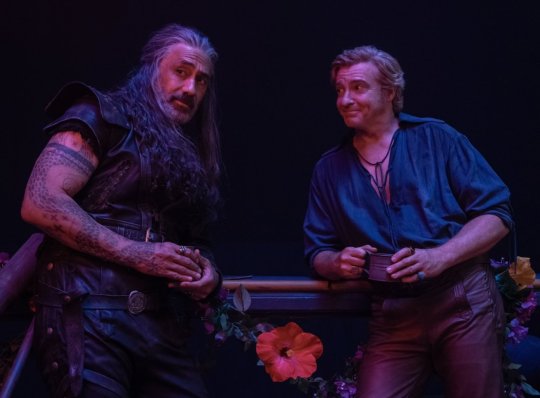
The lighting during this scene is full of color, the reds, purples, and blues. Besides being classic bi lighting, it incorporates the red and purple that we know represents Ed's and Stede's love.
They are swimming in it. Yet, they aren't the same blockingwise, they aren't as close as last season, there is still stuff between them that needs to be spoken. They are standing by each other, their bodies turned inward, and a giant red flower sits bright and center between them, showing how large and full the love they have for each other is.
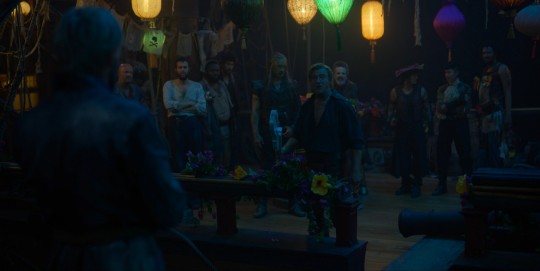
These purples and reds diminish when Ned Lowe crashes the party. His presence brings a screeching halt to the healing and good times the crew and particularly Ed and Stede are having. He not only crashes the party but right before Ed and Stede were about to dance. This giant wrecking ball that symbolizes Ed's pirate past brings in the harsh blue and green lighting and ups the trauma for both men. Green lighting is used to show that things are off, it is off-putting and fills the scene and audience with unease.

Gif credit
The purple lighting stays very subtle during this whole scene, but as Ned insults everyone, and brings up all of the still unspoken insecurities of the men, the blue shines more, especially on Stede as he makes his choice to have Ned walk the plank. We see immediately how that affects Stede, his trauma comes roaring back, he's shaking, and has tears in his eyes. He retreats back to his cabin.
Ed on the other hand is also experiencing trauma here. While helping out and being around Stede, he has been treading water, trying to figure out what he actually wants in life. And the embodiment of that, when he was at his lowest after S1, when he was trying to break the record has come back to taunt him and the man he loves. He chooses to check in on Stede.
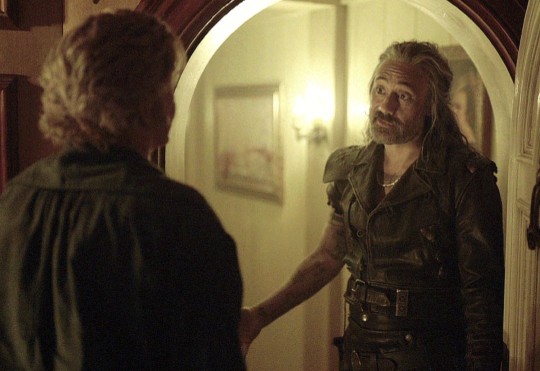
This is when the lighting and camerawork change. We are now inside and the lighting is warm, glowing from candlelight. Ed has a yellow glow behind him when Stede opens the door, like he is the beacon of light in this storm of emotion and trauma that Stede is experiencing from his decision to kill Ned. To cross that boundary when with the rest of the crew he used his usual positive people management style.
Pay attention to their positions here, cause this upcoming choice makes this scene feel off. The pull into the room and the subsequently slam into the wall and kiss are flipped. Along with the quick movements in each shot, this triggers a little part of our brain that realizes something is off even if we don't know why. Read more about the mirror shot in this meta analysis.
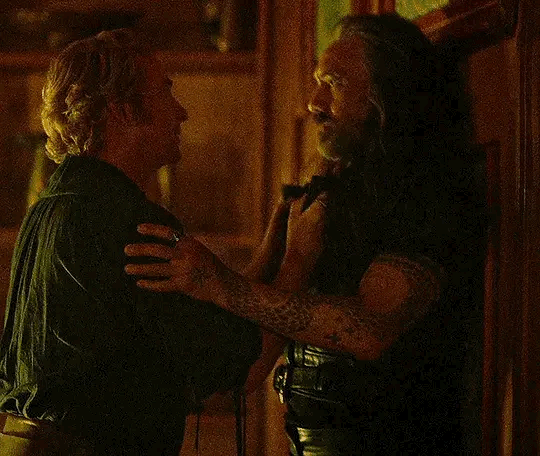
When Ed and Stede decide to be together for the first time, to numb the traumatic pain in their desperation and love for each other the lighting is different. It turns a warming orange/yellow glow, showing the softness of the situation.
These men desperately love each other and want to be together. They both agree to this night, Stede pauses before kissing Ed, waits until Ed nods his head and gives consent then pulls Stede in.
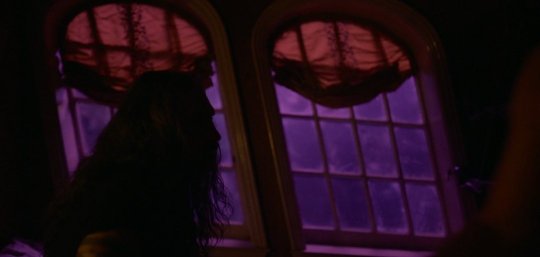
And when Stede closes the curtains, the lighting is back to red and purple. The two colors symbolizing the love these two have for each other.
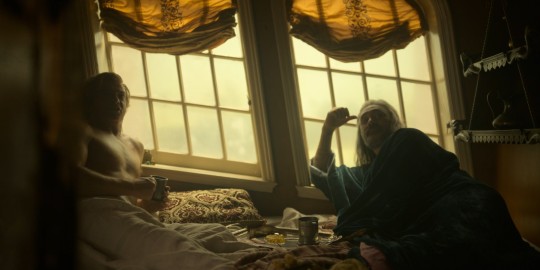
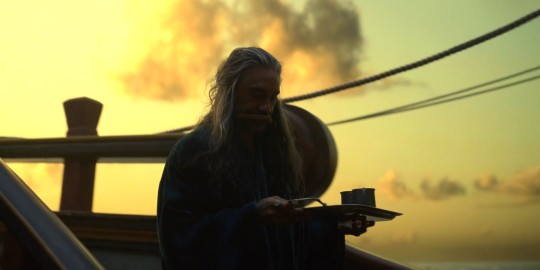
In the morning, the bright yellow lighting is back. The beautiful morning sky in the background looks serene and idyllic, but it also puts our characters in a shadowy haze in the foreground.
They are still in the warmth, the afterglow of being together. Ed gets nervous and brings Stede breakfast in bed. (A parallel to Doug and Mary). They have an intimate conversation where Ed opens up about seeing mermaid Stede while in Purgatory. They have now been intimate in all forms of the word.
But there is still something off, just like with the mirrored images. Stede is shirtless, open, feeling safe. Ed has ditched his leather clothing, his Blackbeard persona, and is now in fine clothing. And I can't confirm but the inside of the robe looks purple. But his robe is closed, which can be read as still hesitant, even if it's subconscious. And they have the same body language of all of the last episode. They are sitting apart, not touching, but still comfortable facing and leaning into each other.
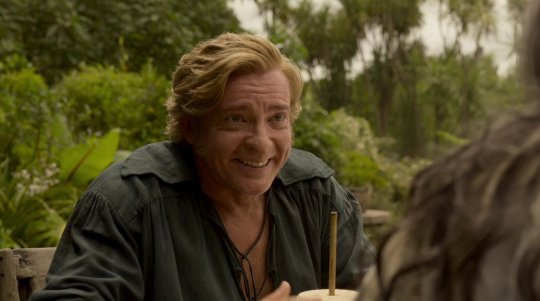
And this bliss continues outside where they open up more. The lighting is bright, pretty, they are surrounded by greens and tans, glowing still. Stede tells him about the multiple letters in bottles he has written. They are opening up about things but they are still avoiding what needs to be talked about - the trauma, their different paths that seem to be emerging.
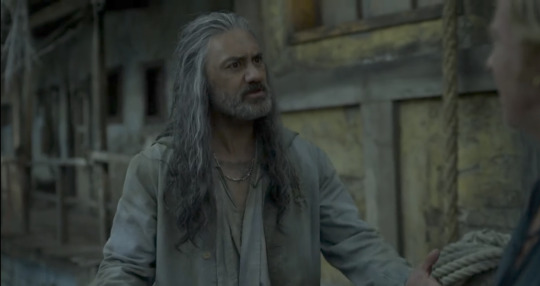
And then finally, when the fight happens, all of the uneasiness from the mirrored shot, the close but not yet close enough body language, all of these choices come crashing down just like the relationship.
The light is muted. They have spent part if not all of the day apart. So the lighting indicates that it is approaching sunset not only in time but in their relationship, the foreshadowing of Ed breaking up with Stede and leaving.
Ed has already made up his mind. He is leaving to be a fisherman. He thinks what happened the night before - and by that - the moving too fast part was a mistake. While they both love and want each other, Ed is self sabotaging - in a direct parallel of last season - thinks he has ruined Stede, spiralling and choosing like he's done in the past to completely run away from the darkness. He needs to learn that he can embrace both (all) sides of himself without losing himself.
Stede tries to save it. Responds to Ed saying "this can be whatever we want it to be." But then things escalate, things aren't explained. Stede doesn't realize what the fish means to Ed, and saying he lied about the quality of the fish is Ed's view of them, "they are the fish."
They need to talk, about what they want, their diverting paths, finding common ground, and learn how to be in this relationship.
They believe the exact opposite of the truth. Ed thinks he's ruined Stede and that Stede won't love him if he's not Blackbeard (the chin convo!) And Stede thinks he isn't good enough for Ed (and everyone, that is why he goes a little crazy when people recognize him - in a direct parallel to Ed during the dinner party in 1x5.) And Ed doesn't love his softness.
All the lighting reaffirms just how much these two love each other, but the blocking, mirrored camerawork, and fast movements show the underlying unresolved tension that has been building up and ultimately leads to this rift.
#our flag means death#ofmd#ofmd s2#ofmd spoilers#our flag means death s2 spoilers#ofmd season 2#stede bonnet#ofmd stede#ed x stede#gentlebeard#ofmd ed x stede#ofmd edward teach#blackbeard#ofmd season two meta analysis#ofmd meta#meta analysis#our flag means death filmmaking analysis
543 notes
·
View notes
Text
Our material world is defined and solidified by the movements of capital. In Pierre Bourdieu’s article “The Forms of Capital” he argues that capital crafts the “games of society”. All of our interactions, with objects, persons, or otherwise are concerned and comprised around our own personal capital accumulation (or lack thereof) and the way in which we choose to exercise it’s use. He does not spell out a solution for the phenomenon of social and cultural capital but merely states the ways in which they exist and the methods persisting that make certain power, influence, will is retained in a hegemony of wealth in the hands of the few.
Pier Paolo Pasolini was a novelist, philosopher, poet, activist, and most prominently a filmmaker in the 50’s, 60’s and 70’s. Pasolini’s films were often distinctly sexual and provocative in a way few filmmakers could attest to, no one had the ability to ignite the tempers of both the intellectual right and left as Pasolini. He was a noted student of Italian philosopher Antonio Gramsci, the influence of Gramsci’s work with cultural hegemony, historicity, and championing of consciousness for the proletariat had an undeniable impact on Pasolini’s work, but his semi-secret life as a homosexual man kept him from falling to easily under any labels as Italian Marxists often didn’t claim him as one of their members due to their homophobia.
His work is his own, difficult to equate to any filmmakers at the time or since, some have compared his filmmaking to that of the Italian neorealists, which seems a lazy assumption based on race and perhaps a collaboration with Fellini, because surely his work is too romantic, heady and occasionally cynical to be saddled with the baggage of that title. He films prostitutes, beggars, murderers, pimps, pedophiles, adulterers, bored monks, horny nuns and marxist crows as if they were saints.
Pier Paolo Pasolini (1922 – 1975) the Italian critic, novelist, film director and screen writer. (Photo by Evening Standard/Getty Images)
In “The Forms of Capital” Bourdieu outlines the structures comprising our daily lives: the realm of cultural and social capital affirm, reaffirm and ultimately define our positions in society. Pasolini’s The Decameron, an adaptation of Giovanni Boccaccio’s seminal collection of 14th century Italian stories, aimed to destabilize this realm, this covering over of the culture of the proletariat which Pasolini would argue is a culture more honest, more true and perhaps more beautiful than that of the hegemony curated by the bourgeoisie. Pasolini’s The Decameron offers a comical, joyful, playful vision of youthful sexuality, subverting many of our assumptions about renaissance society, dangling the possibility that these characters may been more liberated than we because innocence could still exist, persisted and was celebrated. It had not yet been regulated to another form of capital but existed outside the realm of material exchange.
Following the receptive public and cold critical reaction to The Decameron and Pasolini’s following trilogy (Trilogy of Life encompasses The Decameron, The Canterbury Tales, and, Arabian Nights, all resounding commercial successes as far as Pasolini’s overall career is concerned), the creator turned towards the present state of bodies while loosely adapting another classic work of Latin literature Dante’s Divine Comedy resulting in 1975’s Salò, Or the 120 Days of Sodom. Pasolini adapts these staples of world literature in an uncompromising and original execution, he reclaims them for the working class through language, performance, tradition and storytelling. Pasolini captured the degradation of substance, attempting to contaminate the forms of capital with the very freedoms it stripped from the masses: love, truth, clarity. The forms once innocent, can never be again, the history of capital cannot be undone, sexuality, food, art, revolution, morality are now reduced to mere tools of corporate fascism, of which we ourselves are its victims and proprietors.
Pasolini was no stranger to adaptation with The Decameron as he had already translated for the screen not only major works of literature in, Oedipus Rex, Medea, and The Gospel of St. Matthew but he also further explored his own published literary works in Accattone and Teorema. For The Decameron, however, Pasolini reworks both Boccaccio’s stories, muddying their structure and doing away with their framework.
In the original story a group of seven young women and three men attempt to escape the Black Plague ravaging their city and take refuge in the countryside for two weeks. They entertain themselves by telling tales. Over the course of Boccaccio’s text the ten refugees tell one-hundred stories, ten of which Pasolini employs in the film. The other half of the film is composed of ten original episodes inspired by Boccaccio’s tone and style, written by Pasolini himself. In Boccaccio’s version, a leader is chosen for the day to curate the stories around a certain topic of their desire.
One of the primary functions of Boccaccio’s work was not only to reflect on the current state of his time, the plague, religion, sexuality, but also to establish the virtues and ethics surrounding these topics for the coming generations, which for Boccaccio (and Dante) was the renaissance. These writers created immensely popular works that have been read and taught for centuries, not only as items of cultural significance, but much like the bible, became objects of moral foundation. Both the Divine Comedy and The Decameron are taught in private schools, higher learning institutions, taught to the few who dictate the needs of the many. This was particularly true of Pasolini’s era, as there was a stark gap in the education of the Neapolitan farmers he grew up around opposed to the wealthy bourgeois families he depicts in Teorema. If these same affluent children are reading these stories, internalizing their moral guidelines and proliferating them, there must be something corrupt if we have found ourselves in this current society of extreme disparity and division.
Pasolini if anything, reads The Decameron as an ode to the origins of the Italian elite that also belongs to them, “… he will use this text, ironically, to tear cinema away from the bourgeoisie, which has lost its ascendency as a historical force”. Pasolini’s The Decameron is an attempt to wrestle these texts out of the hands of the few and disseminate them back to the people whom the tales are about, the peasants, swindlers, youths, love-makers. The bonds of the forms of capital can be shattered only if we seek to take back the works from their perceived labels and pretensions by means of contaminating the original.
This contamination is a process of inclusion and exclusion, negating the intent of foundational novels, opposing their essential thesis, in order to reach more relevant truths with grander implications for our current existence in post-late-capitalist society, “…a devotedly antagonistic, as it were, cinematic imitato of the original”. Prior to an analysis of the content of contaminating an adaptation is the form, Pasolini furthers his inquiry into form by altering the language of Boccaccio’s text. This is most apparent in a scene where an elderly man sits in the streets reading to a crowd from Boccaccio’s The Decameron he quickly becomes frustrated with the flowery Tuscan dialect and throws the book aside speaking in his native Neapolitan language. If the forms of capital have any power which helps them to retain their divisive nature, their greatest tool is language, the language of the rich and of the poor may as well be taught as two separate classes, in some socioeconomic circumstances they are.
This scene has a meta-commentary undercurrent, in the spirit of the Dirty Projectors Rise Above rendition of the Black Flag album of the same name, Pasolini and this storyteller preaching to a crowd are recounting these tales from memory rather than the page, giving their creative license, new affirmative power over the original forms. This awakened authority begins with language, returning these stories to the people who comprise the content diminishes their stature as documents dictating the behavior of the masses and reemphasizes them as methods of expression, even revolution for the proletariat.
The most crucial indictment of the influential falsehoods concerned with the forms of capital are in the story of Ciappelletto, a murderer, thief and pedophile who finds himself dying in a town where no one knows him after being expelled from another town for rape, forgery and the aforementioned murder. He protects himself from these crimes by participating as a brute debt collector, the debtors often as conniving and vile as he. The film opens with him bludgeoning an unknown character, presumably a debtor, before throwing their body off of a ledge.
When he arrives in this foreign village Ciappelletto is gravely-ill, he’s well aware that these are his last moments for the world, he sends for a priest to absolve him of all his evil sins. Much of the comedy of this scene comes from the audience waiting to hear an honest confession from Ciappelletto in the eyes of his savior, instead he lies, filling the priests ears with an image of an honest, meek, frail and wholesome individual.
With this testimony the priest is brought to tears, blessing this man as a saint in the eyes of God. Ciappelletto dies only to have the church hold a massive funeral procession that raises him to the heights of sainthood. In life Ciappelletto suffered persecution, exile, he is bisexual, poor, ugly and lazy, he’s never been wanted anywhere. In death, however, he is made holy, not only redeemed in his lying but exalted. Whereas Dineo, one of the refugee-storytellers of Boccaccio’s Decameron insists that “the obscenity of his tales is a function of his obedience”, Ciapelletto’s obedience in death is a product of his obscenity in life.
The forms of capital are flimsy, bias and irrational if a man like Ciappelletto is able to reach such pillars of esteem. What strength other than maintaining a hegemony do the forms really have? Are the words of the church, governments in all their conglomerated wealth really enough to uphold goodness? This line of questioning is akin to that of Chaplin in Monsieur Verdoux; Ciappelletto and Verdoux may be ghastly, frightful men in their own regards but they are merely products of human nature reacting to a ghastly, frightful world around them. They harbor only a fraction of the malice that the cruel leaders of our world contain, for Ciappelletto it was kings and queens, for Chaplin the Hitler’s, McCarthy’s, the bankers, for Pasolini it was the capitalist, unwavering and ruthless who differed little from the fascist in their desire for total control. Ciappelletto manipulates the accepted moral exercises of society, social and cultural capital are malleable not only in their content but in their application to the individual, Ciappelletto understands that the material of capital is perhaps far less important than the perceived nobility or convenience of action within its stated bounds. He mimics Boccaccio’s intent while subverting it:
“Boccaccio offers an image of a self-regulating society, which articulates its own rules of comportment, and in which power is identified with, or is derived from, the delimitation of the sayable, the act of imposing a frame upon the field of narrative possibilities: the act of exclusion.”
Ciappelletto has excluded the truth of his own existence and in doing so has achieved the ultimate vindication, in denial he has achieved redemption.
The prevailing triumphant force in the story of Ciappelletto is innocence, a society so lovingly gullible as to be convinced of his purity is one corrupted by a set of ideals, yet unadulterated by another, “…the portrayal of a late-medieval Italian society in ideological and economic crisis, as found in the Decameron, becomes an allegory of late-capitalist society”. The future awaiting them was one that Boccaccio and the Decameron helped establish, the Italian aristocracy which collapsed into dictatorship and finally into capitalism. Innocence during this age persists and has such weight that art and sex prevail over almost every conflict, theological, financial or otherwise.
“The transactions of all the participants in this story, except for the priest-confessor, involve the lending or changing of money, the charging of interest: usury, a practice where money, obviously, is not identical to itself, literal denotative; if this were so then loans would supply no gains for lenders. This practice, furthermore, as Marx describes it in Capital, presupposes the abstraction of money from products of use values. That is usury entails a distancing of currency from the values it once was supposed to reflect.”
Pasolini chose to cherish the products of capital in an effort to distance the two from each other, not to reduce the importance of the products but to reduce the value of capital. Pasolini claimed he created the Trilogy of Life for the pleasure of telling stories, something he restated in interviews and most explicitly in the final moments of his adaptation of Chaucer’s The Canterbury Tales. Perhaps art and sex prevail over the forms of capital because in an Aristotelian sense they are pursued for the sake of themselves. Pasolini is creating something for the sake of itself in both craft and execution transcending capital through the joys of creation.
Sex is a primary focus of The Decameron, one of the earliest stories tracks a young man who leaves his job as a farmer to join a nunnery where he acts as though he is mute, the nuns take advantage of this to engage in the unknown glories of sexual interaction assuming he won’t be able to communicate to their fellow sisters. This would be a fantastic plan if all the nuns weren’t curious and he becomes a kind of living sex-toy for the entire nunnery. The boy breaks his silence to mother superior when he confesses he can no longer get hard because of all the nuns he has been having sex with. The mother superior then runs him into the church declaring God has given them a miracle, in order to work out their sexual situation with proper scheduling and planning, God has embellished the young man with the ability to speak. Innocence and creation once again prevail over the young man’s working conditions on a farm where no women were allowed, he was making money to garner food, increase his social standing, settle down, but he abandoned that to have sex with an entire nunnery, the irony of this inversion of the romantic longing for nature, farming, working with the seasons is eschewed in favor of a life of satisfying the sexual desires of a group of nuns. Through Pasolini’s eyes the latter is more pastoral, wholesome and innocent.
Pasolini casts himself in a brief role as “the artist” a disciple of Giotto, a famous chapel painter, who has traveled to a monastery to construct two murals. He is depicted as restless, taking his meals with the monks quickly and impatiently, eager to get back to his work. When the murals are completed in the films final scene, Pasolini as the artist, with the monks celebrating around him looks upon his work and utters the sentence “why complete a work when it is so beautiful just to dream it”. This line had far reaching implications for Pasolini’s life, proceeding catalog and most crucially to art’s relationship to capital, to the nature of having a “complete” work that for him as a filmmaker necessitates being sold, distributed and commodified the moment it’s finished. Art still possessed the potentiality to be incomplete in the medieval age, its rules and hegemonies had not yet been solidified, molded into cultural and social capital regulated to those who have time to interact with and control it.
Pasolini finished the Trilogy of Life in 1974, it cost him a personal relationship with his longtime lover Ninetto Davoli, who acted in all three films and featured roles in previous movies such as The Hawks and The Sparrows, in addition to his standing as an auteur taking a significant hit. The public reaction to the trilogy was largely receptive as a result of the frequent displays of sex and frivolity, however, the trilogy spawned a number of pornographic imitators, all updating ancient literature into steamy, exploitive depictions of sexual intercourse. Pasolini found innocence and grace in the these bodies, while others sought to intensify how gratuitous and explicit they stood to become. While working on the screenplay for Saló, Pasolini penned an abjuration to to the trilogy, confessing his feeling of loss, “I reject my Trilogy of Life, although I do not regret having made it”. The reception of his films disproves their sentiment: that bodies, sex, art are still pure, capable of immense innocence, but these nude bodies of the young proletariat boys and girls, Italian teenagers, were quickly reduced to pornography and vulgarity.
Sex as a form of exchange had become strictly capital, the act was no longer joyful but commodified, perverted, orchestrated to appeal strictly to base sensation, complete debasement. In the abjuration he calls out specifically the free-love movements of the late 60’s in America and more harshly the May of 68’ in France, feeling that the youths involved in these movements were privileged bourgeoise students who are only revolting out of a sense of entitlement and that they have failed to understand the full implications of their actions, “They do not see that sexual liberation, far from bringing ease and happiness to young people, has made them unhappy, shut off, and consequently, stupidly presumptuous and aggressive”.
Pasolini had succumbed to the helpless cynicism of the forms of capital, a world in which all human connection, projection and sharing is tainted by the material standard of the few. He felt that his trilogy was a failure, in the effort to destabilize the hegemonies of the bourgeoisie he became daunted, discouraged and pessimistic in reaction to the tight grip they have on the life of common people, he no longer saw antiquity with the same warm glow, instead felt the renaissance ushered in the establishment of the Italian aristocracy. The bodies of those paintings, chapels and monasteries had become frail and consumable, and perhaps always were.
“… I am adapting to the degradation and accepting the unacceptable. I maneuver to rearrange my life. I am beginning to forget how things were before. The loved faces of yesterday are beginning to turn yellow. Little by little and without any more alternatives, I am confronted by the present. I adjust my commitment to greater legibility (Saló).”
Saló, or the 120 Days of Sodom is ultimately the synthesis of Pasolini’s renewed cynicism. It was originally planned as part of another trilogy Pasolini’s Trilogy of Death, these films were intended to mirror the structure of the Trilogy of Life, adapting three tales from antiquity, distorting and spoiling their content. He was only allowed to complete Saló as he was murdered by fascists shortly before its release. These films would have explicitly agreed with Bourdieu’s theory but had implications about the state of our relationships that Bourdieu perhaps wasn’t conscious of.
Pasolini extends his method of contamination to its natural limits in Saló, this is an adaptation of the Divine Comedy, employing its form. The characters in the film travel through different circles, applying Dante’s journey into the underworld to a group of youths at the end of the fascist reign, who are enlisted to be sex slaves for the local leaders.
The first circle “Circle of Manias” involves the young boys and girls submitted to large orgies and pornographic stories read over gentle piano music while being groped by older men. Initially these older men submit the children to standard abuses of power, everything is horrific but nothing is yet surprising, the men are still obsessed and interested in the “normal” bounds of sex, they still have some semblance of the sexual morality and ethics imposed on them, the men begin to grow bored with this power; that rape, sex, cuckolding, are simply not enough. The standards of sex, even at their most simple are crafted by fascist powers, Pasolini then moves into his condemnation of what he calls “consumer fascism”.
The second circle “Circle of Shit” involves the fascist leaders growing increasingly disenfranchised with their power, so they long for more to compensate: they begin eating poop, forcing the children to defecate and eat their own waste. Pasolini used this as a metaphor to evoke the fast, cheap food of McDonalds, he felt the death of culture had already begun, right when we started eating our own shit. Further it exists for the pleasure of the few while debasing the masses, the men in all their excess enjoy covering their faces in shit and watching the children eat their excrement off the floor. All capital has been reduced to shit, whereas the forms of capital once retained integrity, pride, and strength, now they are little more than ugly tools serving the shallow sensibilities of the powerful few.
The final circle, “Circle of Blood” is the culmination of the madness of Saló, reducing the forms of capital to a single form: violence. Art, sex, food, beauty have all become vicious, cruel and self-serving. There is a moment of hope dispersed throughout this stomach-churning conclusion, a young girl is found to have a photo of family from home, she then tattles on two girls who have fallen in love, strictly forbidden to have sex with anyone but their masters, the two are threatened until they reveal that one of the young boys is sneaking out to the maids cabin at night and sleeping with her. When the leaders arrive to find the maid and young boy having sex they raise their guns to shoot them, both the young man and woman had starring roles in the Trilogy of Life, here they are slaves about to be murdered for the same acts they committed so carelessly in those films. The young proletariat in defiance forms his hand in a socialist symbol before pumping it into the sky. For just a second the fascists are frightened, the look on their faces recognizes the two most powerful forces in opposition to the forms of capital: love and hope. The film concludes with two young men in military uniform dancing in each other’s arms to the films theme as the sound of children being tortured ring from the courtyard behind them.
“The structures of the cinema therefore present themselves as transnational and transclassist rather than as international or interclassist. They prefigure a possible sociolinguistic situation of a world made tendentially unitary by complete industrialization and by the consequent leveling which implies the disappearance of particular and national traditions.”
Pasolini believed there was very little difference between cinematic reality and the one we experience in everydayness. He found his way towards the cinema as a result of feeling inadequate expression using the novel and poem. His “Cinema of Poetry” captures in its totality, films ability to transcend the forms of capital. Cinema survives but has succumbed to capital in a massive takeover by the corporate powers of industrialization to buy out cineplexes, movies are becoming spectacle rather than stories, blockbusters are becoming the new epic poem. Hegemonies have become so strong that the space for novel ideas, fresh ideologies and interesting solutions to old problems are waining, becoming increasingly stale, bland and repetitive. The forms of capital are brittle yet are more standardized than ever before, “The collapse of the present implies the collapse of the past”, what than of the future?
Further Reading
Bourdieu, Pierre “The Forms of Capital” The Sociology of Economic Life by Mark Granovetter, Routledge (2011). Pg. 46
Patrick, Rumble. Allegories of Contamination: Pier Paolo Pasolini’s Trilogy of Life, University of Toronto Press, 1996. Pgs. 102, 103, 112, 120, 133
Pasolini, Pier Paolo. “Trilogy of Life Rejected” Criterion Collection Spine #631. Pgs. 6, 7, 8
Insights- Fighting Back with Contamination: Pier and Pierre Our material world is defined and solidified by the movements of capital. In Pierre Bourdieu’s article “The Forms of Capital” he argues that capital crafts the “games of society”.
0 notes
Text
The blocking of the show is very deliberate with Stede and Ed. They are always next to each other, level, because they are equals.
One thing I noticed is that who is on the right side of the screen is important. The person standing/sitting on the right is the one who is showing emotional vulnerability.
While I'm not staying both of them aren't showing or are the focus of the shot, (as stated earlier, they are equals) generally the person on the right is the focus in the emotional weight of the scene.
For instance, here's Ed on the right side of the frame.
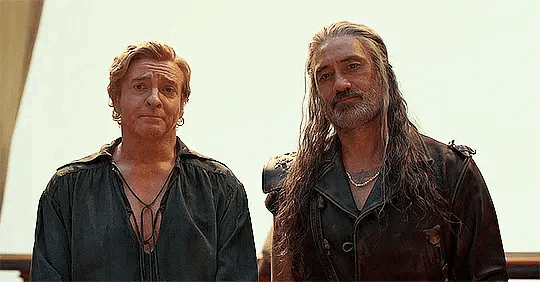
Ed is the one side eyeing Stede, showing the audience his inner thoughts of marriage with Stede. Or at the very least, thinking about Stede while watching the LuPete wedding.

Ed is opening up in this scene, telling Stede about his past, killing his father.

While I will say this is more equal, the focus of the shot is definitely Ed realizing his emotions for Stede.

In the first kiss here, Ed is the one first confessing his emotions to and about Stede, taking the first step forward.
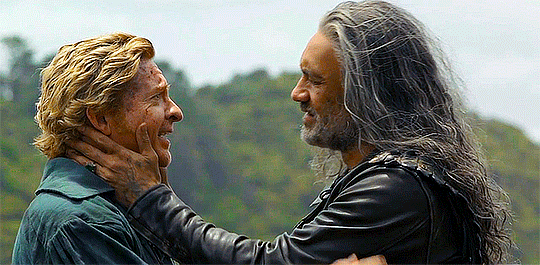
In their last kiss on screen, once again Ed is expressing his emotions. He tells Stede he loves him.
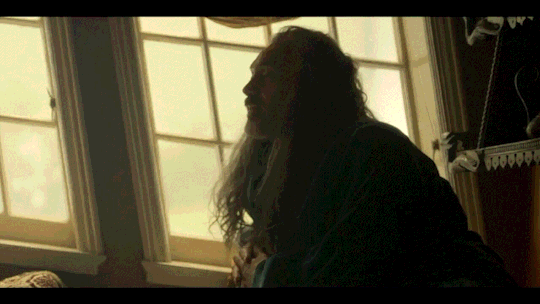
During this scene, Ed is opening up and vulnerable. He tells Stede about seeing him as a mermaid, merman, merperson.
And now Stede on the right!
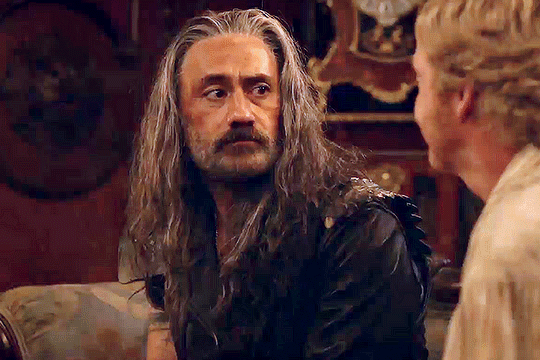
In this scene, Stede is telling Ed he loves him. This is his love confession. Just like the first and last kiss are Ed's.

In a parallel to the morning after breakfast scene, Stede is the one opening up here. He tells Ed about the letters that he's written over the past few months.

In the real world scene, Stede is talking to Ed and trying to bring him back to life. His focus in the real world is important, and balances the focus of Ed's expressions and emotions in the accompanying purgatory shots.
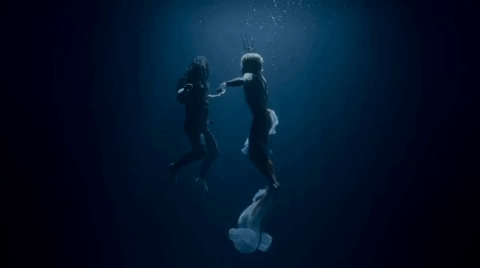
And I'll end with this shot, cause it's just beautiful.
There are many others, but Tumblr only allows ten photos a post.
#ofmd#our flag means death#stede bonnet#gentlebeard#ofmd edward teach#ofmd meta#meta analysis#blocking#our flag means death filmmaking analysis
98 notes
·
View notes
Text
Speaking of light motifs and how light is used in OFMD to show hope and love, I gotta talk about this important bonding moment.

On one hand, this moment is the basis of Ed's burn off Stede's face and take his identity plan; but on the other hand, it is Ed and Stede cementing their ability to work together. They bonded talking about their lives, looking at the fine fabrics, and even switching identities, yet coming up with the plan and executing it shows how well they play and work and is the stepping stone to their partnership.
And the symbolism/motif of light and lighthouses come to the foreground.
For Ed, this light shows the hope he has been missing for years. The hope for a new life, for change, to live, not crack up on the rocks or feel like he's drowning. And it's no coincidence that this moment is with Stede. Ed is so joyful, he hugs Stede for the first time.
For Stede, it represents many of those same things it does for Ed. But he is helping to create this light; he takes the kindling light already there and adds the alcohol to it, making it bigger, creating that lighthouse, saving his crew, and letting that inner light shine on everyone.

I am working on a whole thread of how light is used to symbolize Stede (the overexposure shots in the pilot when Stede's on screen) but also Stede's love and hope to the crew and especially Ed. The way cinematography is used in this show makes my film heart beat overtime.
#ofmd#our flag means death#stede bonnet#gentlebeard#ofmd edward teach#ofmd stede#ed teach#cinematography#ofmd meta#meta analysis#blackbonnet#ofmd season one episode four#discomfort in a married state#our flag means death filmmaking analysis
103 notes
·
View notes
Text
Negative space in 1x10 Wherever You Go, There You Are shows Ed's isolation after shuffling on the Blackbeard/Kraken role.
Continuing my negative space series, this one will also focus on Ed and I guess it would be 2.5.5.
I discussed the meaning of how the negative space in center-framed Ed scenes shows his emotions and mindset: both negative (isolation) and positive (hopeful future).
Let's look at how the end of 1x10 makes Ed small on the screen as the Kraken/BB. (It is also a foil to the larger-than-life framing of Ed. )
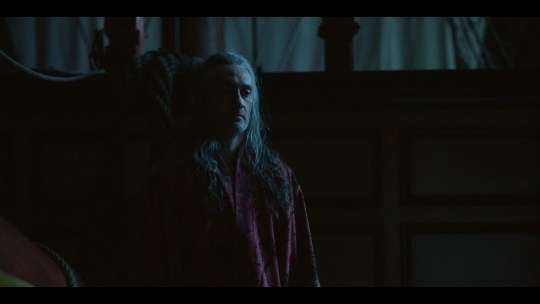


These three shots all show Ed's changing mindset. After Izzy invalidates Ed's feelings and threatens him, he metaphorically shuffles on the dark demeanor here.
Ed becomes increasingly smaller in the frame as the camera changes angles, finally ending with the ship itself as the central focus of the shot. Ed is hidden behind the railing, like bars in a jail cell; he is locked back into the role that was slowly killing him.

He is then hidden in shadows just like when we first meet Blackbeard on his ship. We only get to see a glance of him as he performs an act of violence — first one we've seen him do on camera. His mindset is as shadowed for the audience as it is for Ed. The left side of the frame is empty, no distinguishable shapes, which adds to the disoriented feeling in this moment.

The orangish-red lighting is also a stark contrast to how we've seen Ed lit the rest of the series. It is reminiscent of his intro and during his wedding toppers overnight breakdown in season two.

When Blackbeard starts to cull the crew, recruiting Jim and Frenchie but marooning the others, the shot puts Ed in shadow and small on screen again. Not only is he hidden behind a desk, but there is a huge gap between him and the rest of the crew. This is the beginning of him completely isolating from everyone, not letting them close physically or emotionally.
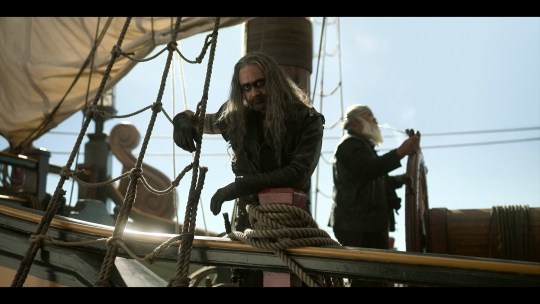
This camera choice of making Ed small in the frame, tons of space around him, and if there is any crew they are far away from him, really drives home how much Ed has to disassociate from everyone in order to put on the persona of Blackbeard. It shows how his mental state has turned dark, he is isolating himself since 1) he feels unlovable and 2) not let anyone close enough to him to hurt him like Stede did.
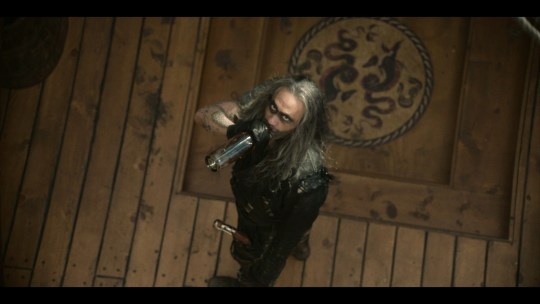
Changing the angle, this overhead shot makes most of Ed's body hidden. The most prominent parts we see are the gun and the bottle of alcohol, vices for his negative isolation and dark headspace.
We've seen Ed drink before but (besides the time with CJ) it is done in celebration or neutral: with the crew, during the co-captains scene. This drinking is about drowning his feelings.
There can also be a parallel to his father being a drunkard. Ed having to take on the toxic vices of his abusers in order to become Blackbeard is a whole other essay, especially when the show has established time and time again that Ed is soft, and tries to state his boundaries when someone is about to cross them, but then they do and he has to react.
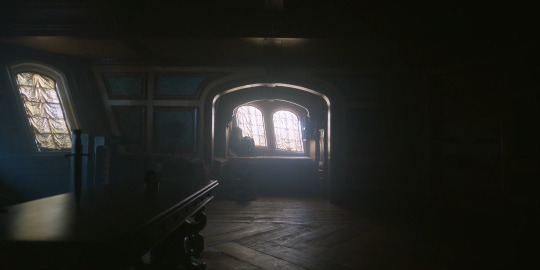
The last shot of Ed in the season one finale is devastating. He has emptied out the captain's quarters of most of Stede's things, the only items we can make out are the tiny piano, the desk, and a knife stuck in the desk (perfect foreshadowing for the knife bit in the next season). Ed is tiny in frame, scrunched up in a ball, on a bed, something that should offer comfort, but it only offers isolation and pain.
Every shot of Ed after he becomes Blackbeard again shows how isolated Ed is, his bed headspace, and how emotionally vulnerable he is only in private.
#ofmd#our flag means death#ofmd edward teach#ofmd meta#blackbeard#kraken era#cinematography#our flag means death filmmaking analysis#meta analysis
37 notes
·
View notes
Text
A scene that I think captures the whole feel and thesis of this show (and specifically season two) is when Archie and Jim first kiss.
We start with Jim and Archie in the hidey hole protecting Izzy. Frenchie, now in the first mate role, tells them to "start with his leg, see where it goes" to save Izzy from the infected gunshot wound, leaving to get the first-aid kit.

Archie and Jim do just that and proceed to sit down in front of a passed-out Izzy, tissues in nostrils to keep the stench away. Pointedly, Jim is still holding onto Izzy's leg and is inspecting it. We get comedy thrown in during and right after the amputation. Joking about which leg to amputate, stating that "oh, he's a gusher," and Jim casually inspecting the leg.

And that is followed immediately by a sweet speech. Jim tells about the good times of the ship, their time with the old crew and specifically Olu. They call Izzy "a dick, but he's their dick" claiming him as part of the crew, the community, and reinforcing that at the heart of it, all of these characters technically aren't "good people," they are pirates, survivors, they've done a lot of morally ambiguous things, but that doesn't mean that they are past saving, past loving, past living.
This part of the scene shows us the community that the crew has for each other, how they are hiding Izzy and trying to keep him alive. It also shows the violence of this way of life. Violence in the past season has always been there but more in a cartoony way — people recover from being gut-stabbed fairly quickly and mysteriously or to the clearly defined bad guys. This season is no longer the fantasy (Note the gusto!) of being a pirate, but the reality of it (Our characters can get fundamentally hurt.)
((And Izzy living from this wound still semi fits the cartoony part of S1 because in reality he would have died from it, but in the show he lives from the wound and recovers fairly quickly, but we don't shy away from the mental and physical trauma of it like S1 would have done.))

As the scene continues, Archie leans in to kiss Jim and when asked why, replies that she likes Jim's optimism. We see here how Archie is used to the real-life violence of pirate life. But Jim, who was raised to be a killer as to seek revenge, has changed into a softer person. One who will try to save the life of the person who was once not enemy but enemy-adjacent. Someone who now tells Fang stories, one who remembers and implements the ways of their old captain to find healing and community in this dark situation.
This moment between Jim and Archie is as sweet and romantic as it can get for two people covered in blood, holding an amputated leg, and noses stuffed with tissue.
The kiss abruptly ends when Frenchie returns with Blackbeard. The moment turns ominous as Blackbeard laughs at them and tells them to leave.
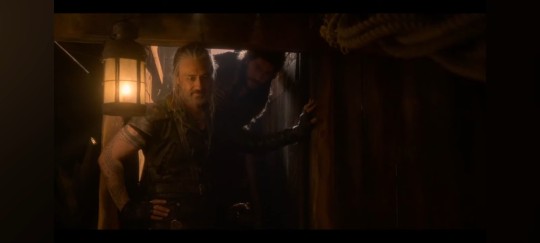
But even in this small scene, comedy still shines through. From Frenchie's lie about not knowing this place existed to Blackbeard's "take the fuckin' leg."

And the scene ends (or where I am ending it for this analysis) with Jim bravely telling Blackbeard that Izzy was his friend.
This whole sequence shows the softness and heart of the show and of these characters in the middle of dark and violent circumstances,
Jim is turned away from the violence and toward the community/romance/comedy while still holding onto the other side the reality/violence, while on the floor with Archie. They then take that evidence of violence turned community/heart with them, balancing all the tones.

This two minute scene truly encapsulates all the elements of the show: humor, romance, community, all forms of love, and the grit of injury and piracy. And I find it fascinating that such a short scene can do all that and why I think it's a perfect example of the themes of the show.
#ofmd#our flag means death#ofmd s2#ofmd season 2#ofmd edward teach#blackbeard#jim jimenez#archie ofmd#ofmd archie#ofmd frenchie#frenchie#ofmd meta#meta analysis#red flags#episode 2x2#thesis#theme#our flag means death filmmaking analysis#i love that this scene encompasses the entire ahow in like two minutes
69 notes
·
View notes
Text


More filmmaking analysis! (My favorite)
The contrast of having these two shots set in the exact same place.
In 2x1:
It's lit in darker lighting like it's nearing sunset. Foreshadowing to the ultimate darkness in Ed's head as well as what will happen to the rest of the crew and the Revenge.
Blackbeard is dressed in his Mad Max outfit and still has the dark makeup on, showing his Kraken era.
Izzy is seen in the shot in the background. During the first season, most shots with the two of them are Ed in the foreground and Izzy in the background. They are doing this again to emphasize Izzy being the one who brought this convo on, that he is the devil on Ed's shoulder.
Ed is manic, moving around, the top of his head breaking the frame of the shot showing his deteriorating mental health.
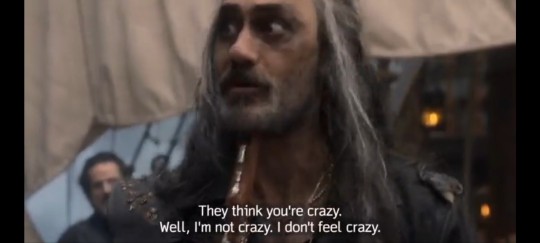
In 2x5:
Ed stands in th exact same spot as in 2x1. But Izzy is no longer over his shoulder in the shot, no longer the devil influencing him. Instead, Stede is next to him, his partner, his equal.
The lighting in this shot is very different, it is bright and light is streaming in from the side, suggesting this is in the morning, a new dawn, day is breaking. The darkness is passed and healing is being ushered in.
Ed is also dressed in different clothes with no dark makeup. He is wearing a light colored sack that offers no space for weapons or violence.
The conversation turns from toxicity to safe (space) ships.
The camerawork is more static as well as Ed's body; his head doesn't break the frame, in fact there is plenty of space in the medium shot above his head to suggest his new mental mind space.


These two scenes are filmed in opposite juxtapositions to show how differently Ed's mind set is, his mental health, the hope of a better day, not the threat of darkness coming to wash them away like an ocean during a storm. Rather the warm glow of the sun promising WARMTH and light.
#ofmd#our flag means death#ofmd s2#ofmd spoilers#our flag means death s2 spoilers#ofmd season 2#meta#filmmaking analysis#our flag means death filmmaking analysis#ofmd edward teach#ed teach#stede bonnet#ofmd stede#i love this show so much
78 notes
·
View notes
Text
It's my favorite time again! Filmmaking analysis time!
How the camerawork used in 2x2 Red Flags shows the power dynamic and tension between Blackbeard and Frenchie.
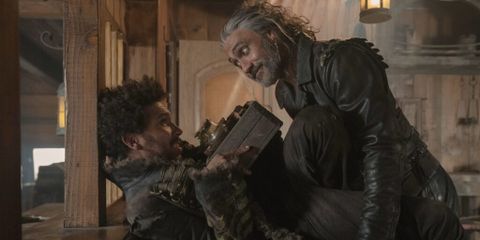
This scene stands out because the camerawork is impeccably used to show the tension, fear, and power dynamic between captain and first mate.
In fact, the camera this season, especially in the first three episodes, has more boldness than the previous season. Since this season is Ed's POV, the camera is more dynamic, the shots are tighter to show emotions, and like in this previous analysis I wrote on "the atmosphere on this ship is toxic" scene in 2x1, it can be used to show the mental state of the crew.
This scene starts out as Frenchie's POV. It starts with him crouched down, holding the first-aid kit, and follows him up as he stands before panning to the right to reveal Ed. It is as much of a jump scare for the audience as it is for Frenchie.
We already are starting with a small amount of tension that just ramps up as the scene goes on. The camera switches to medium shots that are tilted up on both characters.
Let's start with Frenchie's shots.
He is center framed, making sure the audience is focusing entirely on him, and the camera is tilted slightly up. Shots are normally eye-level, so to change this immediately gives us a sense of discomfort.

As Frenchie starts to lie - also, I love you Frenchie but you are a terrible liar - the camera starts to push in closer to him. It shows the audience more fully the discomfort Frenchie's feeling as well as begins the POV of Ed as Blackbeard questions him and walks closer.
The audience feels the same discomfort as Frenchie as Ed slowly advances on him, and we see Frenchie fumble with his words, with the lies, as his face gets closer during the push in.

Now let's switch to Blackbeard.
He is framed in almost the same manner as Frenchie, center, but this time the camera is even more tilted upward. Low angle shots are used to make the subject powerful. And we see that here with how Blackbeard is framed. With Frenchie, we saw from chest up, but with Blackbeard, it is a tighter shot, the audience barely sees his shoulders.
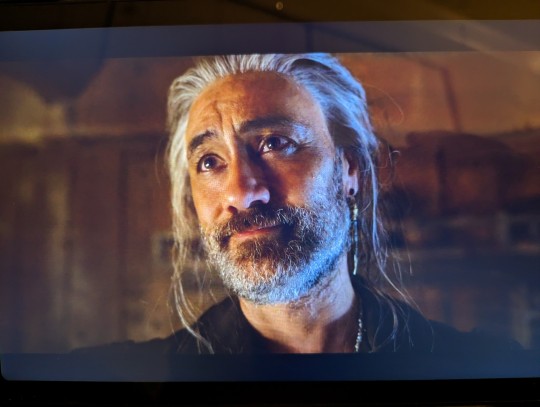
We again have a tracking shot like on Frenchie, but this is the opposite. Blackbeard walks toward the camera, toward Frenchie, causing him to grow larger as he approaches, and we start to feel the suffocation of the moment. And the angle becomes lower as Blackbeard starts winning the conversation, when Frenchie stops trying to come up with excuses and Blackbeard informs him that he knows he's lying.

After the two push in shots show this dynamic the characters' body positions change.
At the end of the scene, Frenchie is lying back completely on the table. His legs in the air as Ed is leaning over him. He is a towering presence and Frenchie is protecting himself with the box - medical supplies - which are covering his face slightly.
The audience only sees Blackbeard's back here because he's already won this situation, this power dynamic.

This POV switch in the camera accomplishes showing the discomfort of the characters and brings that unsettlement to the audience, makes them feel it just like they were in the room. It starts with Frenchie's POV and jump scare, only to then have two different push-ins showing the slow, meticulous advancement of Blackbeard as he intimidates Frenchie. Frenchie gets more despondent as the camera pushes in toward him, until he is finally taken over and laying flat on a table, while Blackbeard takes complete control of this conversation, wins the power dynamic.
The camerawork really ramps up the tension not only between the characters but makes the audience feel it. It starts low on Frenchie, already foreshadowing how the rest of the scene is going to go - with Frenchie "lower" than Blackbeard. Using tracking, low-angle, and push-ins all together in this short scene all to drive home the tension is peak cinema
#ofmd#our flag means death#ofmd spoilers#ofmd s2#ofmd season 2#our flag means death s2 spoilers#ofmd edward teach#blackbeard#ofmd frenchie#ofmd season two meta analysis#ofmd meta#our flag means death filmmaking analysis
58 notes
·
View notes
Text
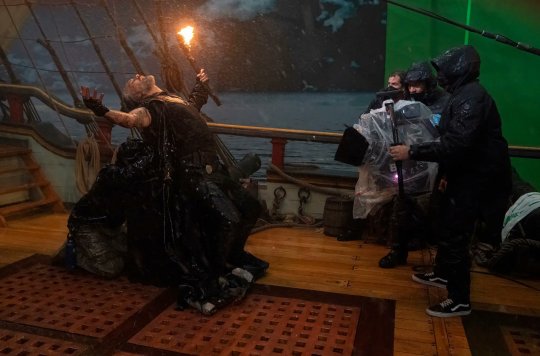
I love this photo because you get to see the unseen bts roles.
- The person kneeling, hidden from camera, and holding the actor up.
- The camera people, and how they protect themselves and the equipment from the rain.
- How Taika is standing on something solid so he doesn't slip on the wet wooden floor in the rain. He is sitting on the cannon but his feet are slip-proof.
- The only live green screens are the ones in the shot.
Filmmaking. Gorgeous.
Photo Credit
#ofmd#our flag means death#ofmd edward teach#taika waititi#ofmd filmmaking analysis#behind the scenes#i love filmmaking#adopt our crew#saveofmd
885 notes
·
View notes
Text
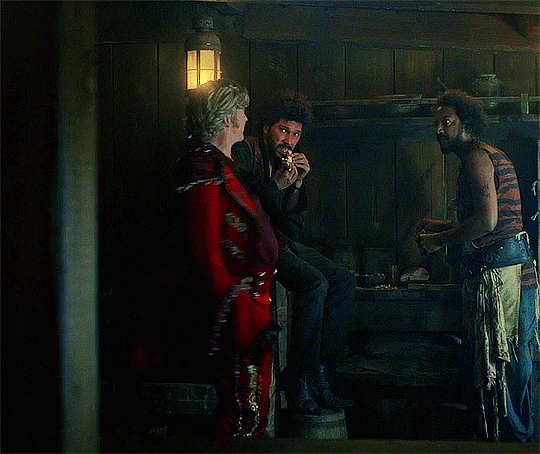
Roach inventing peanut butter. Top notch.
Stede feeling his new fine clothes and twirling with gusto. Fantastic.
The red starkly standing out against the more muted tones of the ship. Filmmaking.
The lantern moving slightly in the background with the sway of the ship? Nice touch.
Frenchie's little tippy toes on the barrel, his folded arms as he eats his sandwich. Adorable.
I love this episode/scene and the filmmaking of this show beyond what I can express.
#ofmd#our flag means death#stede bonnet#ofmd roach#ofmd frenchie#ofmd filmmaking analysis#renew as a crew#saveofmd
120 notes
·
View notes
Text
I'm still thinking about the western-style allegories used in the show.
First the classic standoff shot of shooting through the legs to show the power structure. Ultimately, foreshadowing Stede winning against the bad guys — Izzy and crew. +


Izzy and crew are introduced as the bad guys in western style. There is a 60s-style music cue when the trio are first in frame. They are also small, center-shot in the frame, in the distance, and slightly zoomed on, showing them as the antagonists of the story.
(Also, I didn't include a bad guy shot here for the example, but I just really love City Slickers and wanted to include it.)
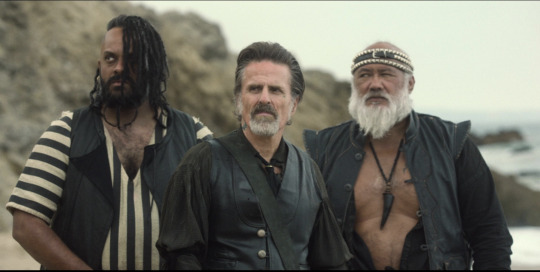


The second duel between Izzy and Stede continues these tropes and symbolism from Westerns. (The closeness, the zoom in, the angle of the weapon against the other.)
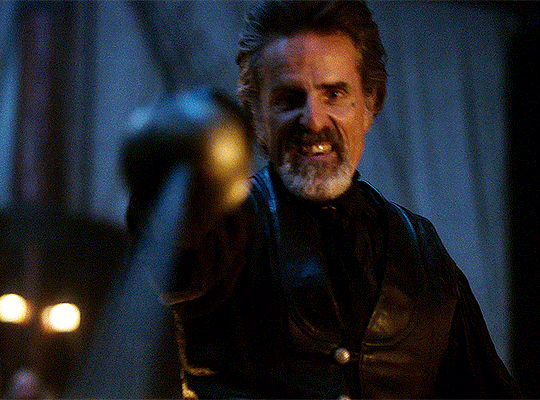
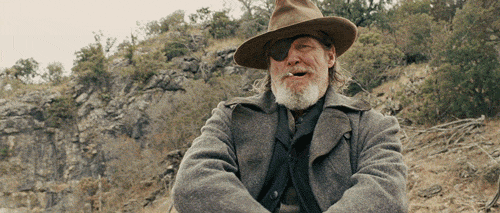
And then the other classic showdown/standoff style. First in season one with Olivia and Calico Jack, and again in season two with Ed at the wedding party — there isn't an accompanying shot there though, because Ed is having a showdown with himself.


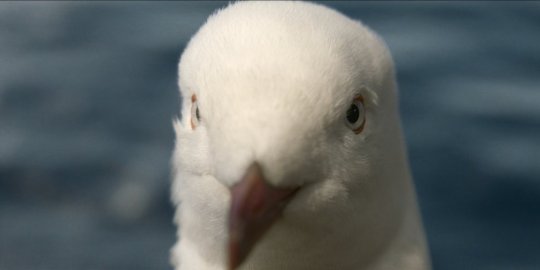
#i probably sound like a broken record with how many posts ive done on this but i cant stop#ofmd#our flag means death#stede bonnet#ofmd edward teach#olivia the seagull#filmmaking analysis#ofmd meta#western#izzy hands#ofmd izzy hands
69 notes
·
View notes
Text
How center-framed shots of Ed's back show his emotional state and isolation
The use of negative space (Part Two)
(Part One: the use of greenery in the negative space of episode 1x7: It's Happening.)
This time I want to focus on the center-framed back shots of Ed.
Not pictured but still important and part of this analysis: When he prepares for Izzy to shoot him in 2x2, the opening of 2x8: Fisherman Ed. (There may be more but that's all I could think of/find at the time of this posting.)
Unlike in Part One, where negative space is mainly used to show the relationship between people/nature, these shots are used to show the mental state of Ed, his isolation. There is no one else present in the frames and often not even in the same room as him.
All of these moments have something in common: Ed is at some of his most vulnerable and alone. And this is shown by how small Ed is in the frame and using the open negative space around him.


1x9 and 2x8 Stede's Absence
Ed is first surrounded by the purple symbolizing his love, Stede not showing lip. Ed is looking out into the vast ocean (he feels like he's drowning.) In the second one, he is surrounded by the ship explosions wreckage, the cinematography color grading is tinted grey just like the previous episode when Stede and Ed fought. Once again, his thoughts are on the absence of Stede. Ed looks at the mainland, away from the ocean, fitting this season's theme of finding ground. These similar shots, trains of thoughts (the tracks leading to Stede), the basic colorless outfits, all show the emptiness in these two moments.


(gif:loveexpelrevolt)
1x3, 1x5, 2x3, 2x8 Ed's Other Personas
Throughout the series, Ed takes on different personas/roles: Jeff the Accountant, Jeff the Innkeeper, the Fisherman, Blackbeard/Kraken. And with every intro to this new character Ed's back is the first thing we see. It is a clue to the audience that this isn't the real Ed, these are personas he shuffles on and has to turn around (in frame) to capture.
For both Jeff personas, Ed turns into the frame, like an actor transforming their identity, a switch of the mind. Jeff's story and journey starts positive but quickly derails into fruatration when things don't go as planned. Ed must drop this identity and go back to just being Ed.
The camera movement in 2x8 with Ed's fisherman persona amplifies how it is different than Jeff's. Instead of Ed turning into the shot, more upbeat and smiley, the camera rotates around Ed to reveal his face. Ed's voiceover during this invokes a calm mindset that Ed is trying to encompass. This calmness means he can stare out into the water, content, not psych himself up to be fake upbeat.
While these shots can symbolize Ed's need to play, they also symbolize how he has compartmentalized himself. Jeff is separate, Blackbeard is separate (he works for him), and the Kraken is separate.
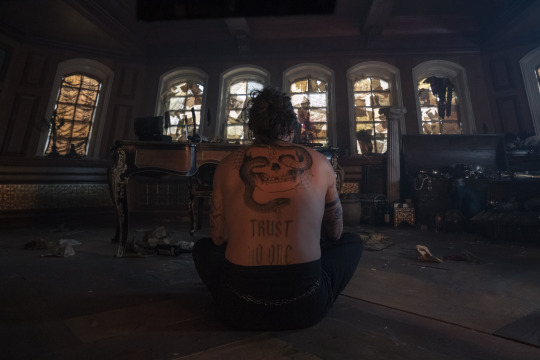
2x1 and 2x2 The Kraken
Ed sits down in the darkened/covered windows of the captain's quarters, arguably in one of the most vulnerable moments we've seen of him. It is the only time Ed is shirtless (other moments of his vulnerability consist of being down to just a t-shirt — the purple of 1x7 and black of 2x3.) While we don't know if the "trust no one" tattoo is new, the ink is darker than his other tattoos, so it at least stands out more. He is surrounded by random objects, bottles of alcohol, and rhino horn.
Missing from here but also part of this conversation is during the scene where he hands Izzy the gun and asks him to shoot him. This is the pinnacle moment of his suicidal tendencies, he puts his arms out in acceptance, his hands free of anything.
These moments are both calm, quiet, both in darkened recesses of the ship (like the darkness of his mind/mental wellbeing at this moment). Ed is at the height of the Kraken persona, but he is also resolute in his final actions. We see this "peace" continue the rest of the episode when he stands at the wheel and turns the ship toward the storm.
The show consistently uses this center-framed shots to visually represent Ed's mental state; the negative space around Ed shows his isolation. The cinematography choices also add to the emotional symbolism, the darkness of the Kraken shots, the grey/purple when Ed's thinking of Stede, to the brighter blue of Purgatory. All this camerawork and cinematography come together in such a beautiful way. I love how good this show is at visual storytelling.
(Part three of this series coming soon.)
#ofmd#our flag means death#ofmd season 2#ofmd edward teach#meta analysis#ofmd meta#kracken era blackbeard#blackbeard#cinematography#filmmaking analysis#adopt our crew#renew as a crew#gentlebeard
75 notes
·
View notes
Text
Let's talk filmmaking and the use of camerawork and framing in this scene!
All of the crew except Ed and Izzy are sitting down. This already shows the power dynamic.
All of the shots of the crew are on stationary cameras, not moving and specifically framed at a slightly up or straight on angle.
This is done to show their more stable mindset compared to Ed. They as well as the camera are stationary, frozen in their positions.

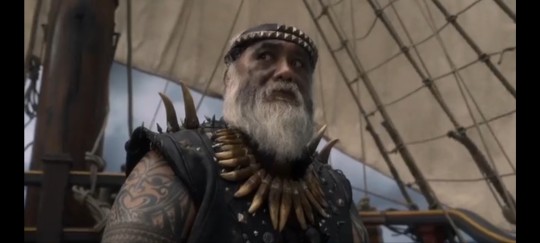

But then we have Izzy. He is standing with a mainly stationary camera as well. But unlike the other crew who are positioned in the middle of the frame, he is off to the side, on the 2/3rds line. This makes him different from the other crew members - he is the one who is going to take the chance, to tell Ed exactly what is going on. He isn't stationary, and he is still standing because he has the power in this scene. He is the one who gets Ed to stop talking.
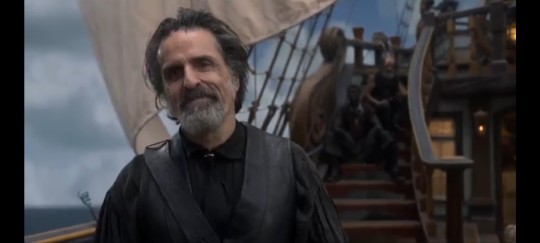
And now Ed.
Ed is the only one who moves around. He gets both a floating camera and a moving body. He is moving so much that the top of his head gets cut off multiple times. In any other shot, this would be a film school 101 no-no. But this is done on purpose, because just like how Ed's head is breaking the camera frame barriers, his mental health is broken.

Ed is also the only one who breaks the 360 degree rule when he turns around. Showing him standing before his crew, above them, not even entirely facing Izzy cause he knows exactly what Izzy is going to say.

The camerawork in this shot is fantastic. It captures and enhances the mindset of every crewmember and the chaotic energy of Ed. The heavily traumatic and conflicting mental and emotional feelings.
#ofmd season 2#ofmd s2#ofmd#our flag means death s2 spoilers#our flag means death#analysis#filmmaking analysis#our flag means dearh filmmakign analysis#this camerawork is so beautiful
133 notes
·
View notes
Text
How negative space shows Ed a hopeful future (Part 2.5)
I want to continue on the Ed negative space theme from Part Two.
Particularly this Ed's back center-framed shot that I kept out of the last thread. That is because this shot is the exact opposite meaning of the isolation in Part Two: How center-framed shots of Ed's back show his emotional state.

In part two, I broke down these shots into three different categories: Stede's absence; when Ed switches into character (Jeff the accountant, innkeeper); and when he is alone while shuffling on the Kraken part of him for protection.
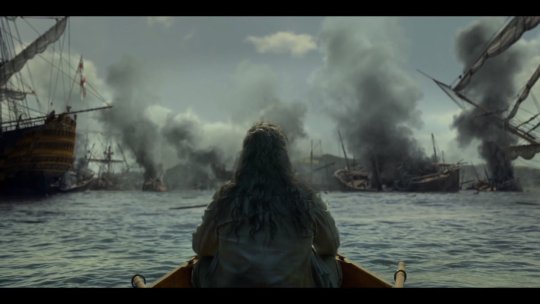
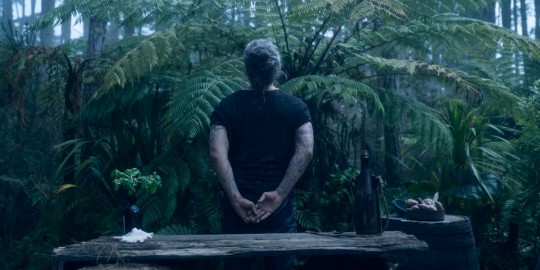
In this shot from 1x4, Ed sits on the couch, shot up from mid-back. The focus of the negative space around him doesn't show isolation but instead hope and a future.
This is one of the rare shots where someone else is actually in the shot when Ed's back is center-framed, and it's no coincidence that it's Stede. The camera placement gives the audience Ed's view of Stede's excitement at being able to show off his cabin and connect with Ed.
It is also a contrast to Ed's captains quarters. Stede's are a rich brown, with lots of shelving for books and trinkets, art. (A fireplace and two chandeliers!) It is warm and inviting.


On the other hand, Ed's cabin on his ship is dark: in lighting, mindset, and aesthetics. Full of items like skulls that reflect the persona of Blackbeard, who is shot with mainly his side and back as the main focus. The light shining through in streams hit him like the thought of Stede broaching Ed's dark thoughts and demeanor as Blackbeard.
Back to this shot.

The lighting in the cabin is rich, warm, welcoming.
Light is a running motif of hope in this series, especially between these two. (Stede's colors are gold/yellow, Ed's are red and purple.) Here, we have one of the large chandeliers shining down on them, particularly Stede, and there is a reflected light right above Ed's head. Like a halo or spotlight, reflecting that joy and hope in front of him. The top of his head and shoulders glow.
Stede's outfit contains three facets: the burnt orange pants that blend in with the aesthetic of the cabin, the white shirt that stands out from the background and draws the eye's attention to Stede, and the black cravat, which we know the importance of the rest of the season.
The curtains framing the shot on each side give the allusion of Stede opening his world up to Ed. And Ed looks at this stage, how his life could change for the better, and he is presented with hope and light, with Stede. The openness of the space isn't negative but positive, just like Ed's future.
Part One: The use of greenery in negative space in episode 1x7: This Is Happening
Part Two: How center-framed shots of Ed's back show his emotional state and isolation
#ofmd#our flag means death#stede bonnet#ofmd edward teach#gentlebeard#filmmaking analysis#meta analysis#ofmd meta#ofmd 1x4#discomfort in a married state#adopt our crew#save ofmd#cinematography
62 notes
·
View notes
Text
Thinking about the use of green-tinted lighting in this scene. It's not like the naturalistic dense fog in 1x4, this fog is green and eerie and makes one feel like something is off.
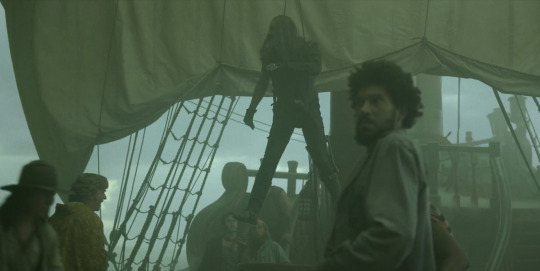
It's one of the first times the show uses green to evoke these emotions. They bring it up again in 2x6 and 2x7 when Ned crashes Calypso's Birthday and when Ed and Stede fight.


Ed uses this eerie lighting to show a fuckery — something that will be utilized multiple times throughout the rest of the show. Stede loves it, his face lights up in joy when he realizes the production Ed puts on — for him. He stays until Ed and Izzy start fighting when Izzy tries to get him down, a comedic moment to end the scene. But also even more telling of the division forming between them with the green lighting setting.
I love the cinematography of this show and I could (and have) write essays about it.
#ofmd#our flag means death#cinematography#ofmd filmmaking analysis#meta analysis#ofmd meta#stede bonnet#ofmd edward teach
42 notes
·
View notes